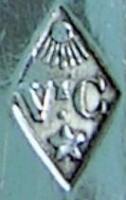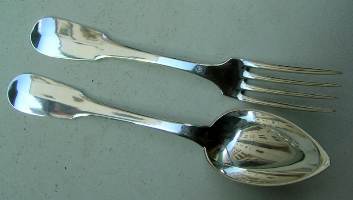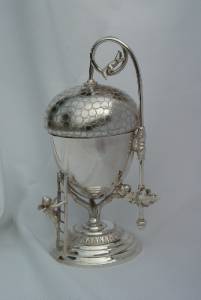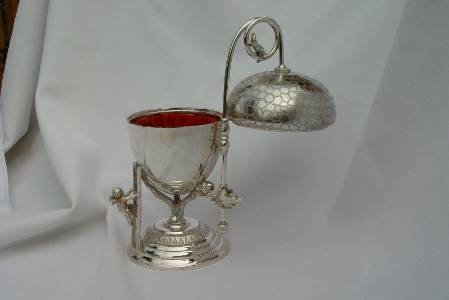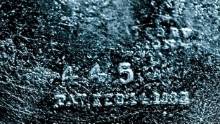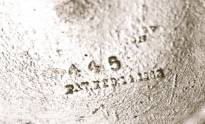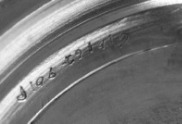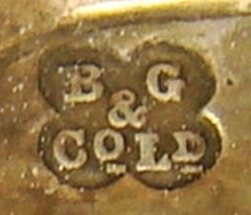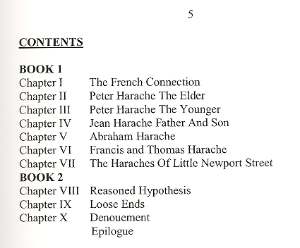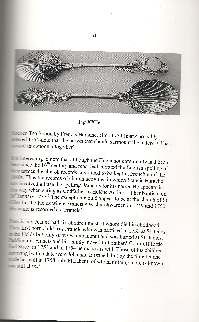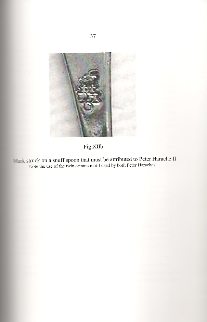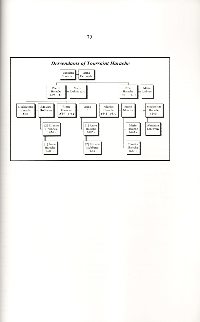|
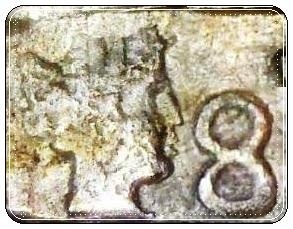
Claudio Morelli and Giorgio
Busetto present:
Five Centuries of Neapolitan Silver Marks 
Cinque secoli di punzoni dell'argento napoletano 
The use of the marking of silver in Naples dates back to
the fourteenth century during the reign of Joanna I of
Anjou. The first official documentation of this practise
dates back only to 1437 and is the privilege issued to
goldsmith Paolo di Roma by King Alfonso of Aragon.
Over the following centuries the Goldsmiths' Corporation
became very powerful, so that the Viceroy Count of
Sant'Esteban, August 19, 1690, promulgated "The
Pragmatic De Monetis LVII.". This Law imposed the
concentration in Naples of all activities involving the
processing of precious metals and the use of 833.33/1000
fineness......
click here  click
here click
here 
|
Welcome to new ASCAS members:
Sharon Cruickhsank - USA
Sonia Garrett - USA
Jurij Gubarev - Canada
Patrizia Mollica - Belgium
Ursula Scott - Belgium
Trevor Walker - New Zealand
Warren L. Whittier - USA
Members' Window # 88
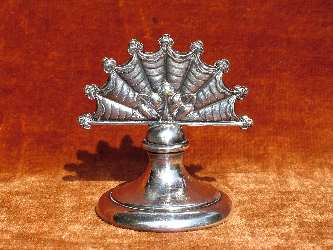
David N. Nikogosyan
presents:
Marks of European Silver Plate: IX. Szandrik,
Austro-Hungary/ Sandrik, Czechoslovakia

In my previous article in ASCAS about Sandrik, due to
wrong information taken from the Slovak website, I made
some mistakes, which I am correcting now. In two words,
this information ignored completely the Hungarian origin
of this company. Actually, this silver production
factory ("ezüstárúgyár" in Hungarian) was built in the
village of Alsó-Hámor, situated in the Kingdom of
Hungary, part of Austria-Hungary, and was operating
through the Hungarian capital. The name of this
Hungarian company was slightly different, not "Sandrik"
but "Szandrik", though both names phonetically sound
similar as the combination of the two letters "SZ" in
Hungarian language corresponds to an "S" in Slovak
language.....
click here 
|
Robert Massart writes:
Dear Giorgio, the the discovery of an unknown maker's mark
solved the enigma of a time gap in the succession of the
silversmith Henri-Louis Chenailler.
An Addendum to
article # 133 - Newsletter # 75 August 2010
In referenced article I pointed out that a time gap of 8 years
existed between the death of Henri-Louis Chenailler on 11 June
1859 and the succession by Henri Chenailler in 1867 (who most
probably was a relative).
The time line also showed that the silversmith Antoine-Félix
Desreux operated the shop, 56 rue Meslay, for five years from
1862 till 1867.
Who operated the business during the period 1859 till 1862
remained unexplained.
Recently I discovered a silver fork and spoon marked with a
maker’s mark VEC.
The mark shows a rising sun over VEC over a five pointed star,
which is in line with the successive marks of Henri-Louis
Chenailler, Antoine-Félix Desreux, Henri Chenailler and Henri
Soufflot.
For this reason I am quite confident that this mark belongs to
the widow of Henri-Louis Chenailler (VE = Veuve = widow), who
most certainly operated the shop from 1859 till 1862.
Robert Massart
Diane Donaldson writes:
... This item was found in the back of a cupboard in my parents
first home they moved into. When my parents passed away, I asked
my brothers and sisters if I could have it.
I took it to a jeweller in Kingston, who in turn sent it to
Toronto to have it cleaned up. The jeweller in Toronto said that
it was over 100 years old. On the bottom of the piece is a
number etched in it "C10262 901P". Then the number 445 and
underneath that is PAT FEB 14, 1783.
Can anyone identify what it is and where it originated from?
I absolutely love it, and will someday pass itdown to my
daughter.
Thank you.
Diane Donaldson
In my opinion your item is a jewelry box.
The metal is silver plate (not sterling silver) and, presumably,
it is of American or Canadian origin. The taste of the piece
suggests it was made late 19th/early 20th century. I'm highly
dubious about the patent date 1783 you read on the bottom. I
believe it is 1883.
Any suggestion by ASCAS members will be highly appreciated.
Giorgio Busetto
In this column we present a page obtained from makers'
brochures, books, auction catalogs, advertising or whatever
other printed paper, related to silver, that may be of interest
for ASCAS members.
The images will be published at a "low resolution" level and for
private and personal use only
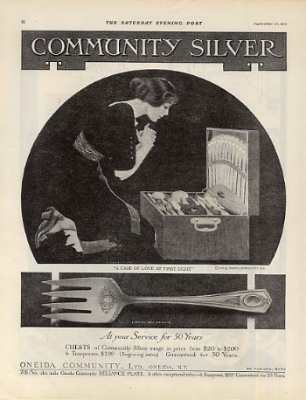
|
This month ASCAS presents an advertisement published
in 1912 on The Saturday Evening Post by
ONEIDA COMMUNITY LTD
Oneida began the manufacture of silverware in
1877. The first two patterns called "Lily" and "Oval"
were made by the Wallingford branch of the firm.
In 1881 the company obtained its first flatware
patterns (Nos. 12,307 and 12,308), but the quality
of its production could not compete with that made
by other companies until 1901 when the new pattern "Avalon"
was exhibited at the Buffalo Exposition.
The new line of Community Plate, introduced in 1902,
was supported by an innovative campaign of
advertising in high-priced, large-circulation
magazines. The "pretty girl" advertising was
enormously effective for the sales of Oneida silver
and had a profound effect in the whole American
advertising business.
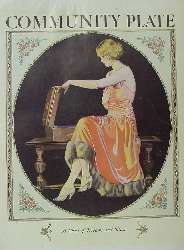
|
"A WORD per MONTH"
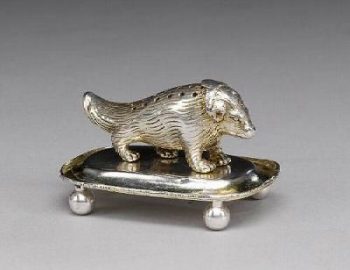
|
TOOTHPICK HOLDER (FIGURAL)
Anthropologists believe that early men picked their
teeth with sticks cut to a sharp point.
Evidence of Stone Age toothpicks is indirect but
compelling and the demonstration is on fossil teeth.
Analysis of their marks has led to the consensus that
they were made by heavy toothpick use by our early
ancestors.
The grooves were especially common in the teeth of
Neanderthals who lived in Europe and Asia, about 100,000
years ago. Similar markings have been found in the
fossilized teeth of both American Indians and Australian
Aborigines........
more
|
"A SILVERSMITH per MONTH"
|
|
BOARDMAN, GLOSSOP & CO LTD
Charles Boardman started
producing sterling silver wares (1844) but converted to
electroplating in 1847 prior to enter in partnership
with A.O. Glossop. Boardman & Glossop was active at 54
Pond St., Sheffield (1861-1871). The firm became
Boardman, Glossop & Co in 1887 and was converted in 1895
into a limited liability company under the style
Boardman, Glossop & Co Ltd (partners were William P. and
Frederick P. Davis).
They were described as silversmiths, electroplaters and
Britannia metal-smiths at Clarence Works, Sheffield and
16 Ely Place, Holborn, London (later at 18 Bartlett's
Building, Holborn)......
more
|
"A BOOK ON MY SHELF"
In this column we present books, new
or ancient, dealing with silver in all its aspects (history,
marks, oddities...). This isn't a "book review" but only a fair
presentation of some useful "tools" that anyone may have in the
shelf of his bookcase.
ASCAS members are invited to contribute to this column
(click to enlarge images)
In the "book on my shelf" of this month ASCAS presents a
book written by David McKinley, an author well known and
appreciated by our members for his articles about English
silver:
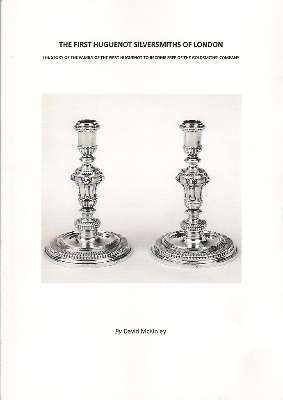
|
THE FIRST HUGUENOT SILVERSMITHS OF LONDON
The story of the family of the first Huguenot
to become free of the Goldsmiths' Company
by David McKinley
(Privately Printed)
-2011-
|
Because of religious intolerance in the late
17th century, there was a mass exodus of
Huguenot craftsmen from France and prominent
among these were goldsmiths.
These craftsmen settled in Germany and Holland
and even as far afield as America. Many went to
England where they lifted the craft to new
artistic heights and the names Crespin, Harache,
Willaume and De Lamerie are now associated with
some of the finest silverware ever produced
there.
The first of these to be made free of the
Goldsmiths’ Company of London was a Pierre
Harache and considerable mystery surrounds him
and his family.
Because of this, a great many misconceptions
have evolved concerning him and his namesakes
and a misunderstanding of who he was, where he
came from and when he died still persist.
This small book, which results from several
years of painstaking research, attempts to
expose the truth about this man and the other
members of his extended family who came to
London and played such an important part in the
production of English silver plate throughout
the 18th century.
As there are still so many unanswered questions
the book has been divided into two parts. The
first deals with the facts and to support these
as many original documents as possible are
referred to. The second tries to answer the
questions with reasoned hypothesis using the
knowledge which comes from an intimate study of
the subject.
In order to keep costs down this 84 page book
has been produced in paperback but no concession
has been made to the quality of either the print
or the illustrations which include examples of
plate and the marks struck thereon.
The published price is Ł16.00 but it is offered
at a discount (Ł12.00 plus postage and packing)
to members of ASCAS and can be ordered on line
at
mckinley.ch@btinternet.com
|
"A CREST per MONTH"
In this column we present images and
descriptions of Crests and Mottoes of British, Irish and
Scottish families as engraved on silver items.
YOUNG
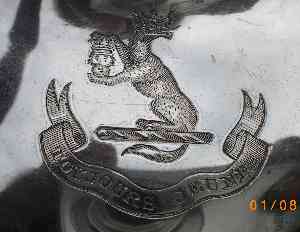
|
James Young, esquire, of
Kingerby, Lincolnshire. A wolf, sejant, regardant,
between paws a human head. The motto is Toujours Jeune
((Always young).
The crest was found on a silver plate vegetable dish
with cover made by Henry Wilkinson & Co.
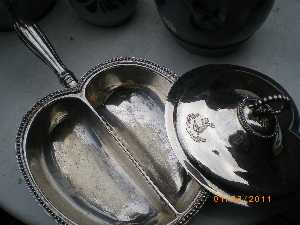

|
If you like this newsletter, support ASCAS clicking on the
+1 button of google
Closing our September 2011 edition of
ASCAS Newsletter I hope you have appreciated its content.
Your comments, suggestions and advice will be of great help.
My thanks to Diane Donaldson, Robert Massart, David McKinley,
Claudio Morelli, David N. Nikogosyan for their invaluable
contributions.
Giorgio Busetto
Secretary
DISCLAIMER AND PRIVACY POLICY
ASCAS is a community of people having a common
interest in antique silver.
It is a non-profit association without commercial links.
Membership is open to whomever has a true interest in
this subject matter.
ASCAS has no real property and no fees are requested nor
accepted from members.
ASCAS keeps in touch with its members only through
periodical newsletters, e-mails and web-site updating
and ignores and is not responsible for any other
activity pursued by its members.
Likewise, ASCAS is not responsible for opinions,
evaluation and images displayed, and in any form
published or supplied for publication, by its members
who, in any case, maintain the property of their works
and assure the respect of national and international
legislation about Intellectual Property.
ASCAS does not have the full addresses of its members (only
town, country and e-mail address are requested for
membership).
ASCAS handles and protects with care its members' e-mail
addresses, will not disclose the addresses to third
parties, will use this information only to reply to
requests received from members and for communications
strictly related to its activity.
These rules are expressly accepted by submitting the
membership request.
|
|
 newsletter
# 88 September 2011
newsletter
# 88 September 2011









